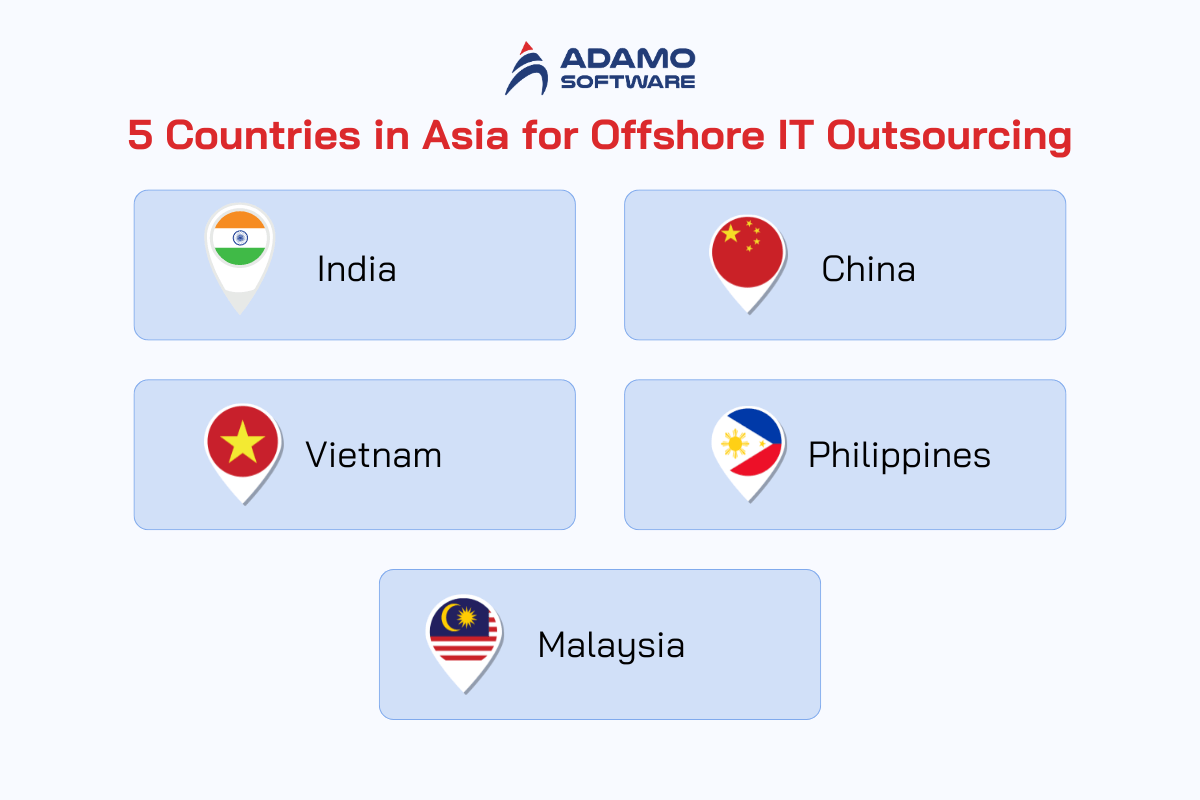Offshore IT Outsourcing: What Is It, Pros & Cons, Top Destinations

Offshore IT outsourcing is a popular model where companies hire skilled professionals from other countries to handle their IT tasks. Thanks to this approach, businesses can save money, access specialized skills, and improve efficiency. However, it also comes with its own set of challenges.
In this article, we’ll explain what offshore IT outsourcing is, discuss its pros and cons, and highlight some of the best destinations for outsourcing IT services.
I. A Look at Offshore IT Outsourcing Statistics
Outsourcing various business functions overseas has become common in many industries, starting with manufacturing. Here are some key statistics that highlight the global trend of offshore IT outsourcing:
_ About 54% of companies worldwide use offshore teams to interact with their customers, showing the widespread use of outsourcing.
_ The global business process outsourcing market is expected to reach USD 525.2 billion by 2030, with a compound annual growth rate (CAGR) of 9.1% from 2022 to 2030
_ Roughly 2/3 of American companies outsource at least one major business process abroad, indicating the strategic value of overseas outsourcing in the US.
_ An impressive 92% of the world’s top 2000 public companies depend on IT outsourcing for their daily operations, emphasizing the essential role of technology services from overseas.
II. What is Offshore IT Outsourcing
Offshore IT outsourcing refers to the practice of a company hiring a third-party provider in a foreign country to perform tasks that are typically done in-house. This can include a wide range of activities, such as software development, customer support, and business process outsourcing.
The term “offshore” simply means that the service provider is located in a another country. Let’s take an example. A company outsources a travel software development project, including travel portal development and website creation, to a software development partner.
Offshore IT outsourcing is popular due to its cost-saving benefits. Companies in countries like the US, Canada, and the UK often outsource to countries like Vietnam, India, and Ukraine because the cost of offshoring is significantly lower than hiring a software development provider from the same countries.
As cost is the biggest challenge for SMEs looking to outsource (according to UpCity), by outsourcing to countries with lower labor costs, they can reduce expenses while still receiving quality services. This cost advantage is a major driver behind the decision to offshore outsourcing.
Also read: What is IT Outsourcing: Types, Models, Cost
III. Advantages of Offshore IT Outsourcing
1. Reduce IT Expenses Due to Completive Pricing
When considering IT salaries, it’s reported that the cost of hiring a software engineer in the US can range from $115,000 to $171,000 per year. Even in countries like Canada, IT salaries are still relatively high, ranging from $75,000 to $100,000.
However, with offshore IT outsourcing, you’ll find that rates become more reasonable. For example, software developers in Vietnam make much less than their American counterparts, with salaries being about four times lower.
What’s more, according to Outsource Accelerator, offshore IT outsourcing can potentially reduce labor costs by up to 70%.
But, despite the lower labor and operating costs, offshore software development companies can provide access to expertise, technology, and resources that are on par with high-salaried countries. You can reduce expenditures while still improving your overall performance and service delivery.
2. Boost Business Innovation
Offshore IT outsourcing can help your business come up with new ideas faster. It means you can get a team of experts without spending time teaching them.
This lets your product teams start working on new things sooner, especially when they need special skills.
Also, hiring people from other countries can give you new ways to think about important decisions. Working with a diverse team can help them share different ideas about markets in other countries.
Doing this not only helps you think of new ideas but also makes you question old ones. This makes your business always come up with new things.
3. Improved Business Flexibility
According to Clutch, 90% of small businesses planned to hire outside help in 2022. They wanted to do this to save time (27%), get more resources (33%), use expert help (26%), and make their business bigger (19%). Small businesses and startups often face unpredictable situations, so partnering with an offshore IT outsourcing software development company can give them the flexibility they need.
Offshore IT outsourcing provides this flexibility, especially if you make a flexible contract with your hired provider. This means the service provider can quickly change to match the way your business is changing so that you stay competitive and meet your business goals.
4. Access to Global Talent
In today’s world, businesses often work together across borders. They outsource to save money and benefit from the skills of other companies. So, one good thing about offshore IT outsourcing is that you can hire people from all over the world.
For instance, let’s talk about India and its IT experts. You can hire them to handle your IT and software needs. Another example is the Vietnam. The IT workforce there are very skilled and dedicated. You can hire them for your software development projects so they can work closely with you and help bring your ideas into market.
III. Offshore vs Onshore vs Nearshore Outsourcing
Both onshore and offshore IT outsourcing have their unique benefits, but there’s another option that’s worth considering: nearshore outsourcing. This involves outsourcing to a neighboring country.

Key differences between Offshore, Onshore and Nearshore outsourcing
1. Geographic location
_ Onshore outsourcing: Services are outsourced within the same country.
_ Nearshore outsourcing: Services are outsourced to a nearby country with similar time zones and cultural traits.
_ Offshore outsourcing: Services are outsourced to a distant country, often far away.
2. Labor cost
_ Onshore outsourcing: Generally higher costs due to proximity.
_ Nearshore outsourcing: A balance between cost savings and proximity.
_ Offshore outsourcing: Significant cost savings due to lower labor and operational expenses in some regions.
3. Time zone differences
_ Onshore outsourcing: Same time zone, making communication and collaboration easier.
_ Nearshore outsourcing: Minimal time zone differences, allowing for easier coordination.
_ Offshore outsourcing: Significant time zone differences, which can impact real-time collaboration.
4. Cultural alignment
_ Onshore outsourcing: Shared cultural values and language, promoting smooth collaboration.
_ Nearshore outsourcing: Cultural similarities with some potential differences.
_ Offshore outsourcing: Possible cultural differences requiring careful management.
5. Communication barriers
_ Onshore outsourcing: Minimal communication barriers.
_ Nearshore outsourcing: Some language differences, but less pronounced than offshore.
_ Offshore outsourcing: Potential for significant language barriers.
6. Regulatory and legal familiarity
_ Onshore outsourcing: Providers are familiar with local laws and regulations.
_ Nearshore outsourcing: Providers know neighboring countries’ legal and regulatory environments.
_ Offshore outsourcing: Requires careful consideration of international legal and regulatory differences.
7. Access to talent pool
_ Onshore outsourcing: Limited to the talent within the same country.
_ Nearshore outsourcing: Broader talent pool from nearby countries.
_ Offshore outsourcing: Access to a global talent pool with diverse skills and expertise.
IV. Drawbacks of Offshore Software Development – How to Handle
1. Communication Barriers
Communication is a crucial part of an IT project. Even if your offshore team is highly skilled, a single misunderstood requirement can lead to delays of days or even weeks.
Dealing with different time zones can be tough for complex projects. A big time gap can make it hard to respond quickly to urgent needs. Unless both sides are willing to adjust their schedules, productivity and communication may suffer.
You can avoid such problems by researching the outsourcing market and the language abilities of potential partners. It’s also helpful to meet the development team before finalizing any agreements.
2. Legal Challenges
When outsourcing overseas, you must consider security and compliance issues. Here are some important things to think about:
_ Compliance: Understand the local laws on data retention (like GDPR, UK-GDPR, DPA, PSD, etc.) to avoid legal problems during development.
_ Cybersecurity: Make sure the provider has strong security measures in place to prevent data breaches.
_ Intellectual Property (IP): There’s a risk of your ideas being stolen by offshore providers, as shown in a 2019 CNBC survey. Even a Non-Disclosure Agreement (NDA) might not be enough protection.
It’s wise to check your partner’s security measures to ensure they meet your standards. Also, involve your legal team to understand the legal aspects of outsourcing in that location.
3. Managing Remote Teams Can Be Complex
Building a good relationship can be hard when your teams are oceans apart. Businesses often have little control over the process and decision-making of the outsourced team. You might find yourself accepting missed deadlines without clear explanations.
But there’s a solution. You need a reliable outsourcing company that takes responsibility for its work.
It sounds simple, but finding the right partner can be tricky. With careful research, however, it’s achievable.
V. Top Ideal Destinations for Offshore IT Development
1. Asia
Asia has long been recognized as a powerhouse in the outsourcing market, offering a vast pool of talent at cost-effective rates and its large, skilled workforce and competitive pricing.

Skills: Asia boasts a diverse range of highly skilled IT professionals. Vietnam, for example, is renowned for its software development and IT services, with expertise in areas like Java, Python, PHP, mobile development, and artificial intelligence. Other countries like China, Vietnam, and Malaysia are also emerging as significant players, offering skills in software engineering, data analysis, and cybersecurity.
Time zone: Time zone differences can be a challenge when working with Asian teams. However, you can find ways to manage this by implementing flexible working hours and overlapping shifts to ensure effective communication. For businesses in the USA, there’s usually a significant time gap, but for companies in Australia and other parts of the Asia-Pacific region, the time overlap can be more manageable.
Cost: The cost of outsourcing in Asia is one of its most attractive features. Rates vary widely across the region but generally range from $15 to $50 per hour, depending on the country and the complexity of the work.
2. Central and Eastern Europe (CEE)
CEE offers good value for money, making it a globally recognized hotspot for offshore IT outsourcing. North American companies, in particular, benefit from the strong IT potential of countries like Poland, Ukraine, the Czech Republic, Hungary, Bulgaria, and Romania, which collectively boast around 1 million software developers.
Skills: The region is home to skilled developers with expertise in various industries. CEE has a solid repository of talent in programming languages such as JavaScript, Java, PHP, Python, Ruby, Android, iOS, and AI/ML. Additionally, it is a good place to hire experts in sectors like Finance/Banking, Healthcare, Security, Gaming, and Automotive.
Time zone: CEE’s time zone offers a significant advantage for real-time collaboration, especially for companies located in Western Europe and the UK. This alignment ensures seamless cooperation between remote and internal team members. Even for offshore IT outsourcing, there are usually a few hours of overlapping work time despite the time zone differences.
Cost: The cost of offshore IT outsourcing in CEE varies from $21 to $118 per hour, excluding vendor fees, according to Accelerance. Ukraine, Moldova, Romania, and Bulgaria offer more affordable rates, while the Czech Republic, Hungary, and Poland have higher living costs, which can affect pricing.
3. Latin America (LATAM)
LATAM has become a go-to region for many companies, especially in the wake of the COVID-19 pandemic. Top offshoring IT outsourcing destinations in LATAM include Brazil, Argentina, and Mexico, with an estimated pool of one million IT experts. Brazil alone accounts for half of this talent pool.
Skills: LATAM’s IT labor market is thriving, bolstered by a strong IT sector, startup culture, and new tech education initiatives. Countries like Brazil, Argentina, and Mexico rank high in tech and innovation skills according to various reports such as Coursera’s Global Skill Report and the Global Innovation Index. Argentine developers excel in computer programming, mobile development, and cloud computing. Mexican developers are strong in data analysis, mobile development, and Python/C++ skills. Brazilian developers are notable for their expertise in cloud computing, data management, and software programming, specializing in languages like JavaScript, HTML, SQL, Java, Node.js, and Python.
Time zone: For companies in the USA, LATAM offers excellent time zone alignment. Mexico shares the same time zone as the USA, providing up to 8 hours of overlapping work time. Brazil and Argentina, in the EST time zone, offer up to 7-5 hours of shared work hours, facilitating real-time collaboration between remote and in-house teams.
Cost: The hourly rates for nearshore outsourcing to LATAM range from $28 to $105 per hour, excluding vendor fees. Brazil has higher rates compared to Mexico and Argentina. Despite this, LATAM remains a cost-effective option for many businesses looking to outsource IT services.
VI. How to Choose the Best Offshore IT Outsourcing partner
Finding the right offshore service provider can greatly enhance your business’s success. You can follow these simple steps to streamline your search process:
_ Choose a location: Start by selecting a country known for its offshore IT outsourcing strengths, such as countries in Asia. These regions offer a skilled workforce and a business-friendly environment.
_ Search for providers: Look online for offshore software development companies in your chosen destination. Seek recommendations from your network to help identify reputable providers.
_ Evaluate options: With a list of potential providers, visit their websites, request quotes, and conduct interviews if possible. Assess their reputation, expertise, technology, and costs.
_ Select the right fit: Choose a partner that matches your industry, company size, and budget. The right provider will understand and effectively meet your business needs.
_ Draft a contract: Create a detailed contract outlining the scope of work, deliverables, costs, and terms.
_ Initiate operations: Once you’ve selected a provider, collaborate with them to ensure a smooth start. Consider a pilot run to confirm that everything is on track.
VII. Why Adamo is A Reliable Offshore Software Development Company
As a company offering offshore IT outsourcing services, we are committed to helping you maximize the benefits of offshore IT. Here’s our approach:
_ Dedicated team approach: We aim to boost your in-house team with fully dedicated resources. The engineers we provide will join your team full-time, working 5 days a week, 40 hours per week. They will follow your company culture, becoming an integral part of your organization and enhancing your home-based team.
_ Customized team formation: Every client is unique, so we carefully select candidates that match your specific requirements in tech skills, company culture, English proficiency, and other competencies. We are committed to meeting your offshore IT staffing needs.
_ Direct communication: You will work directly with your offshore team members, maintaining full control over the team. You can assign tasks and manage the software development process as you see fit, without any intermediaries.
_ Skilled software engineers: At Adamo, we offer access to top talent in Asia and Vietnam. All developers undergo our internal screening process, including tests for tech skills, company fit, and English proficiency. Our targeted offshore locations are known for quality engineers experienced in working with companies in the US, UK, EU, and Australia, ensuring excellent English skills and domain expertise.
Let’s connect to discuss the benefits and challenges of offshore IT outsourcing and how we can help you build your offshore team.











